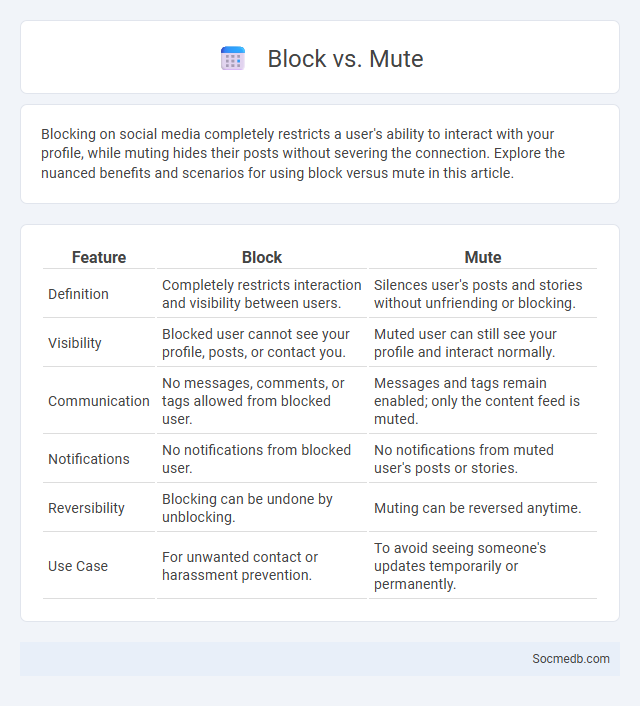
Photo illustration: Block vs Mute
Blocking on social media completely restricts a user's ability to interact with your profile, while muting hides their posts without severing the connection. Explore the nuanced benefits and scenarios for using block versus mute in this article.
Table of Comparison
| Feature | Block | Mute |
|---|---|---|
| Definition | Completely restricts interaction and visibility between users. | Silences user's posts and stories without unfriending or blocking. |
| Visibility | Blocked user cannot see your profile, posts, or contact you. | Muted user can still see your profile and interact normally. |
| Communication | No messages, comments, or tags allowed from blocked user. | Messages and tags remain enabled; only the content feed is muted. |
| Notifications | No notifications from blocked user. | No notifications from muted user's posts or stories. |
| Reversibility | Blocking can be undone by unblocking. | Muting can be reversed anytime. |
| Use Case | For unwanted contact or harassment prevention. | To avoid seeing someone's updates temporarily or permanently. |
Understanding Online Interaction Controls
Online interaction controls on social media platforms enable users to manage privacy settings, filter content, and regulate who can engage with their profiles. Features such as comment moderation, blocking, and muting reduce exposure to harmful interactions and maintain a positive digital environment. Understanding these tools enhances user safety and promotes healthier online communication.
What Does 'Block' Mean?
Blocking on social media means preventing another user from viewing your profile, posts, or interacting with you. When you block someone, your content becomes invisible to them, and they cannot send you messages or friend requests. You control your online experience by choosing who can and cannot connect with your account.
The Functionality of 'Mute'
The functionality of the 'Mute' feature on social media allows you to hide posts or stories from specific accounts without unfollowing or blocking them, maintaining your feed's relevance and peace. This tool optimizes your online experience by filtering out unwanted content while preserving social connections and notifications. By using 'Mute,' your social media interactions become more personalized, reducing information overload and enhancing focus on what truly matters.
Differences Between Block and Mute
Blocking on social media completely restricts the blocked user from interacting with your profile, messages, and content, effectively removing all contact and visibility. Muting, however, only hides the muted user's posts and stories from your feed without notifying them, allowing interactions to continue silently. Understanding these differences helps users manage their online experience by controlling exposure and communication boundaries without severing connections completely.
When to Use Block
Use the block feature on social media when you want to prevent specific users from interacting with your content or viewing your profile to maintain your personal safety and privacy. Blocking is essential if someone harasses, threatens, or behaves offensively, ensuring your online environment remains positive. Make sure you assess the situation carefully; your digital well-being depends on selectively using blocking to avoid unnecessary conflicts or stress.
When to Use Mute
Using mute on social media is essential when you want to reduce distractions from frequent or irrelevant posts without unfriending or unfollowing someone. Muting helps you maintain your feed's quality by temporarily hiding specific accounts' updates, ensuring your social media experience remains enjoyable and focused. You can mute notifications during busy periods or when sensitive topics arise, preserving your mental well-being while staying connected.
Privacy and Safety Considerations
Social media platforms collect vast amounts of personal data, making privacy settings crucial for protecting user information from unauthorized access and potential breaches. Users must regularly update their security preferences, enable two-factor authentication, and be cautious about sharing sensitive details to mitigate risks of identity theft and cyberbullying. Implementing these safety measures enhances overall user security and fosters a more secure digital environment.
Impact on Online Relationships
Social media platforms significantly transform online relationships by enabling constant connectivity and immediate communication, fostering stronger bonds across distances. However, they can also create superficial interactions and misunderstandings due to lack of face-to-face cues, affecting trust and emotional depth. The algorithms behind platforms like Facebook and Instagram prioritize engagement, which often promotes sensational content over genuine connection, influencing how relationships evolve online.
Platform-Specific Features
Social media platforms each offer unique features tailored to their user base, such as Instagram's visual storytelling tools, including Stories, Reels, and IGTV, which emphasize short-form video and image sharing. Twitter's real-time interaction is driven by microblogging and hashtag usage, enabling rapid news dissemination and community engagement. LinkedIn focuses on professional networking through features like job postings, endorsements, and LinkedIn Learning, fostering B2B connections and career development.
Choosing the Right Option for You
Choosing the right social media platform depends on your goals, target audience, and content style. Each platform, from Instagram's visual appeal to LinkedIn's professional network, offers unique opportunities tailored to different user needs. Your focus should align with where your audience spends time and the type of engagement you want to foster.
 socmedb.com
socmedb.com